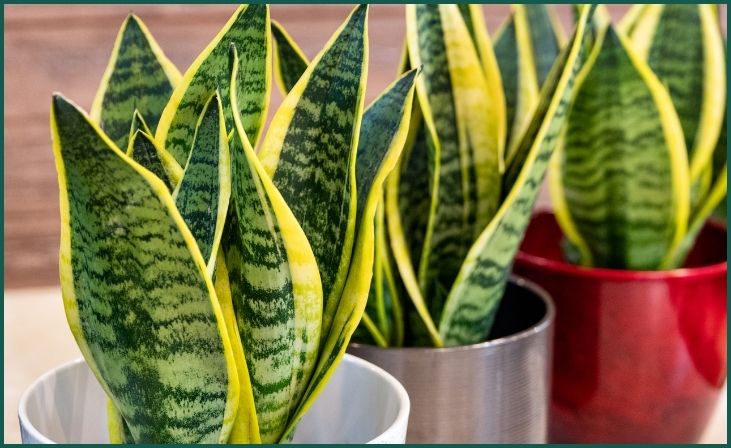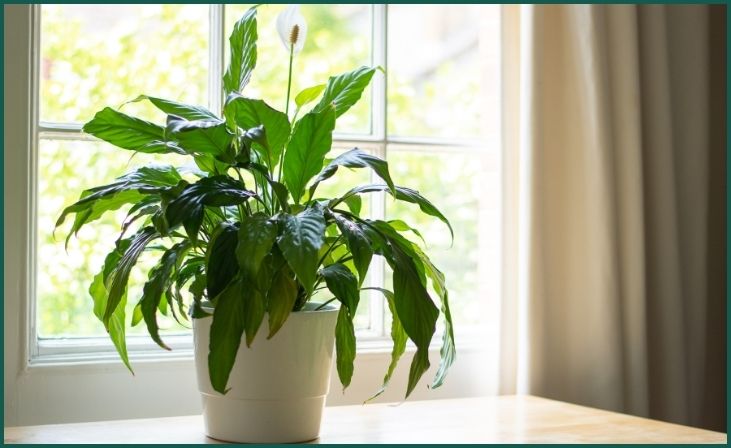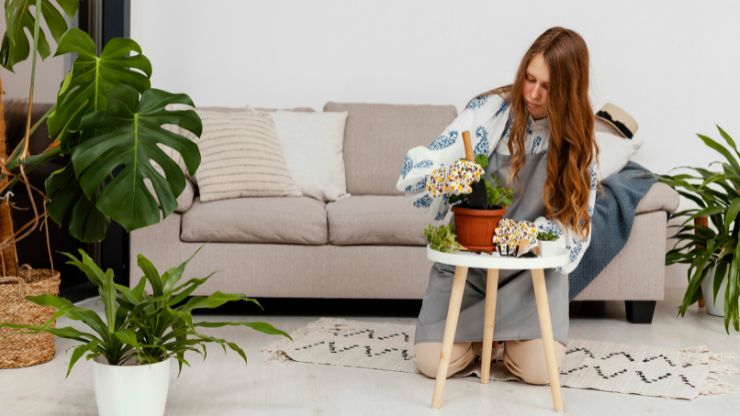Indoor plants not only add a touch of green to your living space but also offer a myriad of health benefits. From improving air quality to boosting mood and productivity, these plants are a must-have for any home. In this article, we’ll explore eight of the finest indoor plants that are not only beautiful but also beneficial for your health and well-being. Whether you’re a seasoned plant parent or just starting, these plants are easy to care for and will thrive in various indoor environments. Let’s dive in and discover the beauty and benefits of these green companions.
Table of Contents
Toggle8 Of The Finest Indoor Plants For Home And Health
1. Snake Plant (Sansevieria trifasciata)

Snake plants, also known as mother-in-law’s tongue, are popular indoor plants known for their air-purifying properties. They are easy to care for and can thrive in low light conditions, making them ideal for beginners. Snake plants have tall, upright leaves that come in a variety of patterns and colors, adding a touch of elegance to any room. These plants are also known for their ability to remove toxins such as formaldehyde and benzene from the air, making them a great choice for improving indoor air quality.
Snake plants are excellent additions to bedrooms, living rooms, or offices where they can add a pop of greenery without requiring much maintenance. They are drought-tolerant plants, meaning they can go for long periods without water, making them perfect for busy individuals or those who may forget to water their plants regularly. Snake plants are also believed to have air-purifying properties that can help remove harmful toxins from the air, making them beneficial for your health. Overall, snake plants are versatile, aesthetically pleasing, and beneficial for both your home and health.
Also Read: Cool Plants for Wet Soil
2. Spider Plant (Chlorophytum comosum)
Spider plants are another excellent choice for indoor gardening enthusiasts. These plants are characterized by their long, arching leaves and small, white flowers. Spider plants are known for their air-purifying properties and ability to remove toxins like formaldehyde and xylene from the air. They are also easy to care for and can thrive in a variety of conditions, making them a popular choice for indoor gardens. Spider plants are great for hanging baskets or placed on shelves where their trailing leaves can cascade down, adding a touch of greenery to any space. They are also safe for pets, making them a great choice for households with animals. Spider plants are relatively low-maintenance and can thrive in indirect sunlight, making them suitable for most indoor environments.
3. Peace Lily (Spathiphyllum)

Peace lilies are beautiful indoor plants known for their elegant white flowers and dark green leaves. They are not only aesthetically pleasing but also help improve indoor air quality by removing toxins like ammonia and formaldehyde. Peace lilies are relatively low-maintenance and can thrive in low light conditions, making them a great choice for offices or rooms with minimal natural light. However, it’s important to note that peace lilies are toxic to pets if ingested, so they should be kept out of reach of animals. Peace lilies are also known for their ability to improve humidity levels, making them ideal for dry indoor environments. Their beautiful flowers can last for several weeks, adding a touch of elegance to any room. Peace lilies are also easy to care for, requiring only regular watering and occasional fertilization.
4. ZZ Plant (Zamioculcas zamiifolia)
The ZZ plant is a popular choice for indoor gardening due to its ability to thrive in low light conditions and its tolerance to neglect. This plant has glossy, dark green leaves that add a touch of elegance to any room. The ZZ plant is also known for its air-purifying properties and ability to remove toxins like xylene and toluene from the air. It requires minimal watering and can go weeks without attention, making it an ideal choice for busy individuals or those new to gardening. ZZ plants are perfect for offices or rooms with minimal natural light, as they can thrive in fluorescent lighting. They are also drought-tolerant, meaning they can survive long periods without water, making them perfect for forgetful plant owners. ZZ plants are relatively slow-growing, so they require minimal pruning or maintenance.
Don't just scroll, subscribe!
BuzzTrail's unique web-stories are the cure for boredom you've been waiting for.
5. Aloe Vera (Aloe barbadensis miller)

Aloe vera is a versatile plant known for its medicinal properties. It has thick, fleshy leaves that contain a gel-like substance rich in vitamins, minerals, and antioxidants. Aloe vera is commonly used to soothe sunburns and skin irritations, making it a must-have plant for any home. In addition to its medicinal properties, aloe vera also helps improve indoor air quality by removing toxins like formaldehyde and benzene from the air. Aloe vera plants are easy to care for and require minimal maintenance. They thrive in bright, indirect light and should be watered sparingly to avoid root rot. Aloe vera plants can also be propagated easily, making them a great choice for beginner gardeners looking to expand their collection. Overall, aloe vera plants are beautiful, beneficial for your health, and easy to care for, making them a great addition to any indoor garden.
6. Rubber Plant (Ficus elastica)
Large, eye-catching indoor plants with thick, glossy leaves are called rubber plants. They can flourish in a range of environments and are generally simple to care for. Rubber plants are useful for eliminating formaldehyde and other pollutants from indoor environments. They are also good air purifiers. These plants do best in rooms with lots of space because, with the right care, they can get fairly large. Rubber plants are ideal for filling voids or spacious areas with a little greenery. When the top inch of soil feels dry, they should be watered. They prefer bright, indirect light. Rubber plants are a fantastic option for novice gardeners wishing to increase the size of their collection because they are also simple to multiply. Rubber plants are a popular option for indoor gardeners because they are aesthetically pleasing, good for the quality of the air inside, and reasonably simple to maintain.
7. Boston Fern (Nephrolepis exaltata)

Boston ferns are elegant indoor plants known for their feathery, arching fronds. They are relatively easy to care for and can thrive in moderate to bright, indirect light. Boston ferns are also effective at removing toxins like formaldehyde and xylene from the air, making them a great choice for improving indoor air quality. These plants prefer high humidity, so it’s important to mist them regularly or place them in a humid environment. Boston ferns are perfect for adding a touch of greenery to bathrooms or kitchens, where they can thrive in the higher humidity levels. They require regular watering to keep the soil moist and should be placed in a well-draining potting mix to prevent root rot. Boston ferns are also relatively easy to propagate, making them a great choice for beginner gardeners. Overall, Boston ferns are beautiful, beneficial for indoor air quality, and relatively easy to care for, making them a popular choice for indoor gardeners.
8. Pothos (Epipremnum aureum)
Pothos plants are popular indoor plants known for their trailing vines and heart-shaped leaves. They are easy to care for and can thrive in low light conditions, making them ideal for offices or rooms with minimal natural light. Pothos plants are also effective at removing toxins like formaldehyde and benzene from the air, making them a great choice for improving indoor air quality. These plants are also versatile and can be grown in hanging baskets or trained to climb a support structure.
Also Read: 7 Prettiest Flowers in the World
Conclusion
In conclusion, incorporating indoor plants into your home can significantly enhance your living environment and promote better health. The eight plants highlighted in this article are not only visually appealing but also offer a range of benefits, from purifying the air to reducing stress and boosting your mood. Whether you choose a low-maintenance succulent or a leafy spider plant, adding greenery to your home is a simple yet effective way to improve your overall well-being. So, why wait? Bring home one of these indoor plants today and enjoy the beauty and benefits they bring.
FAQs
Which indoor plants are best for low light conditions?
Which indoor plants are best for low light conditions?
Some of the best indoor plants for low light conditions include snake plants, pothos, and ZZ plants. These plants can thrive in areas with minimal natural light, making them ideal for offices and rooms with few windows.
How often should I water my indoor plants?
How often should I water my indoor plants?
The frequency of watering indoor plants depends on factors such as the type of plant, the size of the pot, and the environmental conditions. In general, it’s best to water your plants when the top inch of soil feels dry to the touch. Avoid overwatering, as this can lead to root rot.

